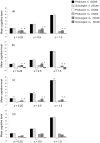An arms race between producers and scroungers can drive the evolution of social cognition
- PMID: 24822021
- PMCID: PMC4014306
- DOI: 10.1093/beheco/aru002
An arms race between producers and scroungers can drive the evolution of social cognition
Abstract
The "social intelligence hypothesis" states that the need to cope with complexities of social life has driven the evolution of advanced cognitive abilities. It is usually invoked in the context of challenges arising from complex intragroup structures, hierarchies, and alliances. However, a fundamental aspect of group living remains largely unexplored as a driving force in cognitive evolution: the competition between individuals searching for resources (producers) and conspecifics that parasitize their findings (scroungers). In populations of social foragers, abilities that enable scroungers to steal by outsmarting producers, and those allowing producers to prevent theft by outsmarting scroungers, are likely to be beneficial and may fuel a cognitive arms race. Using analytical theory and agent-based simulations, we present a general model for such a race that is driven by the producer-scrounger game and show that the race's plausibility is dramatically affected by the nature of the evolving abilities. If scrounging and scrounging avoidance rely on separate, strategy-specific cognitive abilities, arms races are short-lived and have a limited effect on cognition. However, general cognitive abilities that facilitate both scrounging and scrounging avoidance undergo stable, long-lasting arms races. Thus, ubiquitous foraging interactions may lead to the evolution of general cognitive abilities in social animals, without the requirement of complex intragroup structures.
Keywords: game theory; intraspecific arms race; social foraging; social intelligence hypothesis..
Figures




Similar articles
-
An asymmetric producer-scrounger game: body size and the social foraging behavior of coho salmon.Theor Ecol. 2018;11(4):417-431. doi: 10.1007/s12080-018-0375-2. Epub 2018 May 1. Theor Ecol. 2018. PMID: 30931016 Free PMC article.
-
Food-caching chickadees with specialized spatial cognition do not use scrounging as a stable strategy when learning a spatial task.Proc Biol Sci. 2023 Jul 12;290(2002):20230900. doi: 10.1098/rspb.2023.0900. Epub 2023 Jul 12. Proc Biol Sci. 2023. PMID: 37434529 Free PMC article.
-
Stable producer-scrounger dynamics in wild birds: sociability and learning speed covary with scrounging behaviour.Proc Biol Sci. 2017 Apr 12;284(1852):20162872. doi: 10.1098/rspb.2016.2872. Proc Biol Sci. 2017. PMID: 28404775 Free PMC article.
-
The evolution of intelligence in mammalian carnivores.Interface Focus. 2017 Jun 6;7(3):20160108. doi: 10.1098/rsfs.2016.0108. Epub 2017 Apr 21. Interface Focus. 2017. PMID: 28479979 Free PMC article. Review.
-
Foraging Cognition: Reviving the Ecological Intelligence Hypothesis.Trends Cogn Sci. 2017 Sep;21(9):691-702. doi: 10.1016/j.tics.2017.05.011. Epub 2017 Jun 15. Trends Cogn Sci. 2017. PMID: 28625354 Review.
Cited by
-
The Janus face of Darwinian competition.Sci Rep. 2015 Sep 10;5:13662. doi: 10.1038/srep13662. Sci Rep. 2015. PMID: 26354182 Free PMC article.
-
Cultural evolutionary theory: How culture evolves and why it matters.Proc Natl Acad Sci U S A. 2017 Jul 25;114(30):7782-7789. doi: 10.1073/pnas.1620732114. Epub 2017 Jul 24. Proc Natl Acad Sci U S A. 2017. PMID: 28739941 Free PMC article.
-
Integrative studies of cultural evolution: crossing disciplinary boundaries to produce new insights.Philos Trans R Soc Lond B Biol Sci. 2018 Apr 5;373(1743):20170048. doi: 10.1098/rstb.2017.0048. Philos Trans R Soc Lond B Biol Sci. 2018. PMID: 29440515 Free PMC article.
-
Within-group relationships and lack of social enhancement during object manipulation in captive Goffin's cockatoos (Cacatua goffiniana).Learn Behav. 2017 Mar;45(1):7-19. doi: 10.3758/s13420-016-0235-0. Learn Behav. 2017. PMID: 27406172 Free PMC article.
-
Guides and cheats: producer-scrounger dynamics in the human-honeyguide mutualism.Proc Biol Sci. 2023 Nov 8;290(2010):20232024. doi: 10.1098/rspb.2023.2024. Epub 2023 Nov 8. Proc Biol Sci. 2023. PMID: 37935365 Free PMC article.
References
-
- Barnard CJ. 1984. Producers and scroungers: strategies of exploitation and parasitism. London: Chapman & Hall
-
- Barnard CJ, Sibly RM. 1981. Producers and scroungers: a general model and its application to captive flocks of house sparrows. Anim Behav. 29:543–550
-
- Blanckenhorn WU. 2000. The evolution of body size: what keeps organisms small? Q Rev Biol. 75:385–407 - PubMed
-
- Bonduriansky R, Brassil CE. 2005. Reproductive ageing and sexual selection on male body size in a wild population of antler flies (Protopiophila litigata). J Evol Biol. 18:1332–1340 - PubMed
-
- Bugnyar T, Heinrich B. 2006. Pilfering ravens, Corvus corax, adjust their behaviour to social context and identity of competitors. Anim Cogn. 9:369–376 - PubMed
Grants and funding
LinkOut - more resources
Full Text Sources
Other Literature Sources

